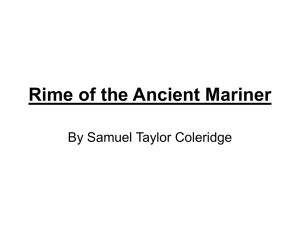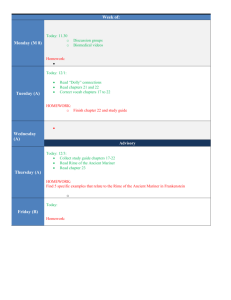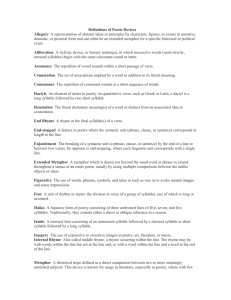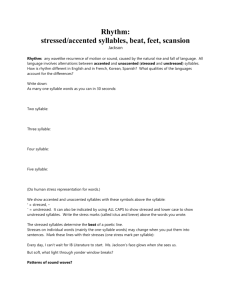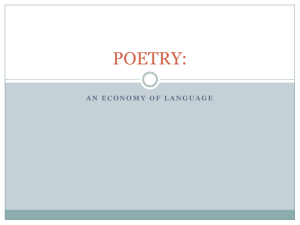Perrine 7 lit terms-poetry
advertisement
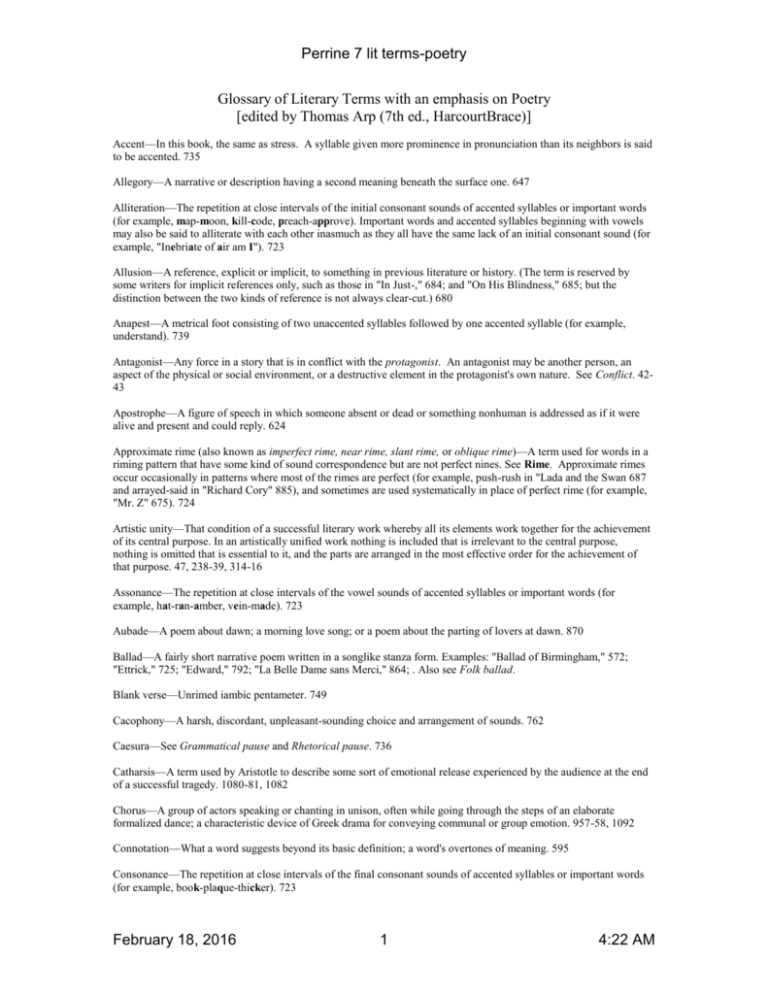
Perrine 7 lit terms-poetry Glossary of Literary Terms with an emphasis on Poetry [edited by Thomas Arp (7th ed., HarcourtBrace)] Accent—In this book, the same as stress. A syllable given more prominence in pronunciation than its neighbors is said to be accented. 735 Allegory—A narrative or description having a second meaning beneath the surface one. 647 Alliteration—The repetition at close intervals of the initial consonant sounds of accented syllables or important words (for example, map-moon, kill-code, preach-approve). Important words and accented syllables beginning with vowels may also be said to alliterate with each other inasmuch as they all have the same lack of an initial consonant sound (for example, "Inebriate of air am I"). 723 Allusion—A reference, explicit or implicit, to something in previous literature or history. (The term is reserved by some writers for implicit references only, such as those in "In Just-," 684; and "On His Blindness," 685; but the distinction between the two kinds of reference is not always clear-cut.) 680 Anapest—A metrical foot consisting of two unaccented syllables followed by one accented syllable (for example, understand). 739 Antagonist—Any force in a story that is in conflict with the protagonist. An antagonist may be another person, an aspect of the physical or social environment, or a destructive element in the protagonist's own nature. See Conflict. 4243 Apostrophe—A figure of speech in which someone absent or dead or something nonhuman is addressed as if it were alive and present and could reply. 624 Approximate rime (also known as imperfect rime, near rime, slant rime, or oblique rime)—A term used for words in a riming pattern that have some kind of sound correspondence but are not perfect nines. See Rime. Approximate rimes occur occasionally in patterns where most of the rimes are perfect (for example, push-rush in "Lada and the Swan 687 and arrayed-said in "Richard Cory" 885), and sometimes are used systematically in place of perfect rime (for example, "Mr. Z" 675). 724 Artistic unity—That condition of a successful literary work whereby all its elements work together for the achievement of its central purpose. In an artistically unified work nothing is included that is irrelevant to the central purpose, nothing is omitted that is essential to it, and the parts are arranged in the most effective order for the achievement of that purpose. 47, 238-39, 314-16 Assonance—The repetition at close intervals of the vowel sounds of accented syllables or important words (for example, hat-ran-amber, vein-made). 723 Aubade—A poem about dawn; a morning love song; or a poem about the parting of lovers at dawn. 870 Ballad—A fairly short narrative poem written in a songlike stanza form. Examples: "Ballad of Birmingham," 572; "Ettrick," 725; "Edward," 792; "La Belle Dame sans Merci," 864; . Also see Folk ballad. Blank verse—Unrimed iambic pentameter. 749 Cacophony—A harsh, discordant, unpleasant-sounding choice and arrangement of sounds. 762 Caesura—See Grammatical pause and Rhetorical pause. 736 Catharsis—A term used by Aristotle to describe some sort of emotional release experienced by the audience at the end of a successful tragedy. 1080-81, 1082 Chorus—A group of actors speaking or chanting in unison, often while going through the steps of an elaborate formalized dance; a characteristic device of Greek drama for conveying communal or group emotion. 957-58, 1092 Connotation—What a word suggests beyond its basic definition; a word's overtones of meaning. 595 Consonance—The repetition at close intervals of the final consonant sounds of accented syllables or important words (for example, book-plaque-thicker). 723 February 18, 2016 1 4:22 AM Perrine 7 lit terms-poetry Continuous form—That form of a poem in which the lines follow each other without formal grouping, the only breaks being dictated by units of meaning. 777 Couplet—Two successive lines, usually in the same meter, linked by rime. 782 Dactyl—A metrical foot consisting of one accented syllable followed by two unaccented syllables (for example, mer-rily). 739 Dactylic meter—A meter in which a majority of the feet are dactyls. (But see Triple meter.) 739 Denotation—The basic definition or dictionary meaning of a word. 595 ?Deus ex machina ("god from the machine")—The resolution of a plot my some use of a highly improbable chance or coincidence (so named from the practice of some Greek dramatists of having a god descend from heaven at the last possible minute—in the theater by means of a stage machine—to rescue the protagonist from an impossible situation). 47-48 Didactic poetry—Poetry having as a primary purpose to teach or preach. 798 Dilemma—A situation in which a character must choose between two courses of action, both undesirable. 43-44 Dimeter—A metrical line containing two feet. 740 Dipodic foot—The basic foot of dipodic verse, consisting (when complete) of an unaccented syllable, a lightly accented syllable, an unaccented syllable, and a heavily accented syllable, in that succession. However, dipodic verse accommodates a tremendous amount of variety, as shown by the examples in the text. ø Dipodic verse—A meter in which there is a perceptible alternation between light and heavy stresses. See Dipodic foot. ø ?Direct presentation of character—That method of characterization in which the author, by exposition or analysis, tells us directly what a character is like, or has someone else in the story do so. 77-78 Double rime—A rime in which the repeated vowel is in the second last syllable of the words involved (for example, politely-rightly-spritely); one form of feminine rime. 724, 731 Dramatization—The presentation of character or of emotion through the speech or action of characters rather than through exposition, analysis, or description by the author. See Indirect presentation of character. 78, 240-41 Duple meter—A meter in which a majority of the feet contain two syllables. Iambic and trochaic are both duple meters. 739 End rime—Rimes that occur at the ends of lines. 724 End-stopped line—A line that ends with a natural speech pause, usually marked by punctuation. 763 English (or Shakespearean) sonnet—A sonnet riming ababcdcdefefgg. Its content or structure ideally parallels the rime scheme, falling into three coordinate quatrains and a concluding couplet; but it is often structured, like the Italian sonnet, into octave and sestet, the principal break in thought coming at the end of the eighth line. 782, 783-84 (Exercise 1) Euphony—A smooth, pleasant-sounding choice and arrangement of sounds. 762 Expected rhythm—The rhythmical expectation set up by the basic meter of a poem. 747 Extended figure (also known as sustained figure)—A figure of speech (usually metaphor, simile, personification, or apostrophe) sustained or developed through a considerable number of lines or through a whole poem. 629, 630 ?Farce—A type of drama related to comedy but emphasizing improbable situations, violent conflicts, physical action, and coarse wit over characterization or articulated plot. 1086 February 18, 2016 2 4:22 AM Perrine 7 lit terms-poetry Feminine rime—A rime in which the repeated accented vowel is in either the second or third last syllable of the words involved (for example, ceiling-appealing; hurrying-scurrying). 724, 731 Figurative language—Language employing figures of speech; language that cannot be taken literally or only literally. 620 Figure of speech—Broadly, any way of saying something other than the ordinary way; more narrowly (and for the purposes of this book) a way of saying one thing and meaning another. 620 Fixed form—A form of poem in which the length and pattern are prescribed by previous usage or tradition, such as sonnet, limerick, villanelle, haiku, and so on. 780 Folk ballad—A narrative poem designed to be sung, composed by an anonymous author, and transmitted orally for years or generations before being written down. It has usually undergone modification through the process of oral transmission. 762 (Question 1) Foot—The basic unit used in the scansion or measurement of verse. A foot usually contains one accented syllable and one or two unaccented syllables, but the monosyllabic foot, the spondaic foot (spondee), and the dipodic foot are all modifications of this principle. 738 Form—The external pattern or shape of a poem, describable without reference to its content, as continuous form, stanzaic form, fixed form (and their varieties), free verse, and syllabic verse. 777. See Structure. Free verse—Nonmetrical verse. Poetry written in free verse is arranged in lines, may be more or less rhythmical, but has no fixed metrical pattern or expectation. 736 Grammatical pause (also known as caesura)—A pause introduced into the reading of a line by a mark of punctuation. Grammatical pauses do not affect scansion. 736, 748 Haiku—A three-line poem, Japanese in origin, narrowly conceived of as a fixed form in which the lines contain respectively five, seven, and five syllables (in American practice this requirement is frequently dispensed with). Haiku are generally concerned with some aspect of nature and present a single image or two juxtaposed images without comment, relying on suggestion rather than on explicit statement to communicate their meaning. 785 Heard rhythm—The actual rhythm of a metrical poem as we hear it when it is read naturally. The heard rhythm mostly conforms to but sometimes departs from or modifies the expected rhythm. 747 Heptameter—A metrical line containing seven feet. ø Hexameter—A metrical line containing six feet. 740 Hyperbole—See Overstatement. Iamb—A metrical foot consisting of one unaccented syllable followed by one accented syllable (for example, rehearse). 739 Iambic meter—A meter in which the majority of feet are iambs. The most common English meter. 739 Iambic-anapestic meter—A meter that freely mixes iambs and anapests, and in which it might be difficult to determine which foot prevails without actually counting. ø Imagery—The representation through language of sense experience. 707 Internal rime—A rime in which one or both of the rime-words occur within the line. 724 Italian (or Petrarchan) sonnet—A sonnet consisting of an octave riming abbaabba and of a sestet using any arrangement of two or three additional nines, such as cdcdcd or cdecde. 781, 783-84 (Exercise 1) Limerick—A fixed form consisting of five lines of anapestic meter, the first two trimeter, the next two dimeter, the last line trimeter, riming aabba; used exclusively for humorous or nonsense verse. 780 Masculine rime (also known as single rime)—A rime in which the repeated accented vowel sound is in the final syllable of the words involved (for example, dance-pants, scald-recalled). 723, 731 February 18, 2016 3 4:22 AM Perrine 7 lit terms-poetry Metaphor—A figure of speech in which an implicit comparison is made between two things essentially unlike. It may take one of four forms: (1) that in which the literal term and the figurative term are both named; (2) that in which the literal term is named and the figurative term implied; (3) that in which the literal term is implied and the figurative term named; (4) that in which both the literal and the figurative terms are implied. 620-23 Meter—The regular patterns of accent that underlie metrical verse; the measurable repetition of accented and unaccented syllables in poetry. 737 Metonymy—A figure of speech in which some significant aspect or detail of an experience is used to represent the whole experience. In this book the single term metonymy is used for what are sometimes distinguished as two separate figures: synecdoche (the use of the part for the whole) and metonymy (the use of something closely related for the thing actually meant). 625 Metrical pause—A pause that supplies the place of an expected accented syllable. Unlike grammatical and rhetorical pauses, metrical pauses affect scansion. ø (See p. 1491, Metrical variations. 740) Monometer—A metrical line containing one foot. 740 Monosyllabic foot—A foot consisting of a single accented syllable (for example, shine). ø Moral—A rule of conduct or maxim for living expressed or implied as the "point" of a literary work. Compare Theme. 662 Octameter—A metrical line containing eight feet. ø Octave—(1) An eight-line stanza. (2) The first eight lines of a sonnet, especially one structured in the manner of an Italian sonnet. 781 Onomatopoeia—The use of words that supposedly mimic their meaning in their sound (for example, boom, click, plop). 760 Onomatopoetic language—Language employing onomatopoeia. Overstatement (or hyperbole)—A figure of speech in which exaggeration is used in the service of truth. 660 Paradox—A statement or situation containing apparently contradictory or incompatible elements. 659 Paradoxical situation—A situation containing apparently but not actually incompatible elements. The celebration of a fifth birthday anniversary by a twenty-year-old man is paradoxical but explainable if the man was born on February 29. The Christian doctrines that Christ was born of a virgin and is both God and man are, for a Christian believer, paradoxes (that is, apparently impossible but true). 59 Paradoxical statement (or verbal paradox)—A figure of speech in which an apparently self-contradictory statement is nevertheless found to be true. 659 Paraphrase—A restatement of the content of a poem designed to make its prose meaning as clear as possible. 581-83 Pentameter—A metrical line containing five feet. 740 Personification—A figure of speech in which human attributes are given to an animal, an object, or a concept. 623 Petrarchan sonnet—See Italian sonnet. Phonetic intensive—A word whose sound, by an obscure process, to some degree suggests its meaning. As differentiated from onomatopoetic words, the meanings of phonetic intensives do not refer to sounds. 760 Poeticizing—Writing that uses immoderately heightened or distended language to sway the reader's feelings. 241 Prose—Non-metrical language; the opposite of verse. ø February 18, 2016 4 4:22 AM Perrine 7 lit terms-poetry Prose meaning—That part of a poem's total meaning that can be separated out and expressed through paraphrase. 691 Prose poem—Usually a short composition having the intentions of poetry but written in prose rather than verse. 737 ?Quality fiction—Fiction that rejects tested formulas in an attempt to give a fresh interpretation of life. 6 Quatrain—(1) A four-line stanza. (2) A four-line division of a sonnet marked off by its rime scheme. 782 Refrain—A repeated word, phrase, line, or group of lines, normally at some fixed position in a poem written in stanzaic form. 725, 779 Rhetorical pause (also known as caesura)—A natural pause, unmarked by punctuation, introduced into the reading of a line by its phrasing or syntax. (Rhetorical pauses do not affect scansion.) 736, 748 Rhetorical poetry—Poetry using artificially eloquent language, that is, language too high-flown for its occasion and unfaithful to the full complexity of human experience. 798 Rhythm—Any wavelike recurrence of motion or sound. 735 Rime (or rhyme)—The repetition of the accented vowel sound and all succeeding sounds in important or importantly positioned words (for example, old-cold, vane-reign, court-report, order-recorder). The above definition applies to perfect rime and assumes that the accented vowel sounds involved are preceded by differing consonant sounds. If the preceding consonant sound is the same (for example, manse-romance, style-stile), or if there is no preceding consonant sound in either word (for example, aisle-isle, alter-altar), or if the same word is repeated in the riming position (for example, hill-hill), the words are called identical rimes. Both perfect rimes and identical rimes are to be distinguished from approximate rimes. 723 Rime scheme—Any fixed pattern of nines characterizing a whole poem or its stanzas. 778-80 Run-on line—A line which has no natural speech pause at its end, allowing the sense to flow uninterruptedly into the succeeding line. 736 Sarcasm—Bitter or cutting speech; speech intended by its speaker to give pain to the person addressed. 663 Satire—A kind of literature that ridicules human folly or vice with the purpose of bringing about reform or of keeping others from falling into similar folly or vice. 663 Scansion—The process of measuring verse, that is, of marking accented and unaccented syllables, dividing the lines into feet, identifying the metrical pattern, and noting significant variations from that pattern. 740 Sentimentality—Unmerited or contrived tender feeling; that quality in a story that elicits or seeks to elicit tears through an oversimplification or falsification of reality. 798 Sentimental poetry—Poetry aimed primarily at stimulating the emotions rather than at communicating experience honestly and freshly. 797 Sestet—(1) A six-line stanza. (2) The last six lines of a sonnet structured on the Italian model. 781 Simile—A figure of speech in which an explicit comparison is made between two things essentially unlike. The comparison is made explicit by the use of some such word or phrase as like, as, than, similar to, resembles, or seems. 20-23 Single rime—See Masculine rime. Soliloquy—A speech in which a character, alone on the stage, addresses himself or herself; a soliloquy is a "thinking out loud," a dramatic means of letting an audience know a character's thoughts and feelings. 910 Sonnet—A fixed form of fourteen lines, normally iambic pentameter, with a rime scheme conforming to or approximating one of two main types—the Italian or the English. 781-82 Spondee—A metrical foot consisting of two syllables equally or almost equally accented (for example, true-blue). 739 February 18, 2016 5 4:22 AM Perrine 7 lit terms-poetry Stanza—A group of lines whose metrical pattern (and usually its rime scheme as well) is repeated throughout a poem. 740, 778 Stanzaic form—The form taken by a poem when it is written in a series of units having the same number of lines and usually other characteristics in common, such as metrical pattern or rime scheme. 778 Stress—In this book, the same as Accent. But see 735 (footnote). Structure—The internal organization of a poem's content. See Form. 777 Syllabic verse—Verse measured by the number of syllables rather than the number of feet per line. 755 Also see Haiku. Symbol (literary)—Something that means more than what it is; an object, person, situation, or action that in addition to its literal meaning suggests other meanings as well, a figure of speech which may be read both literally and figuratively. 182-87, 639 Synecdoche—A figure of speech in which a part is used for the whole. In this book it is subsumed under the term Metonymy. 625 Terza rima—An interlocking rime scheme with the pattern aba bcb cdc, etc. 791 Tetrameter—A metrical line containing four feet. 739 Theme—The central idea of a literary work. 102-109, 581 Tone—The writer's or speaker's attitude toward the subject, the audience, or herself or himself; the emotional coloring, or emotional meaning, of a work. 704 Total meaning—The total experience communicated by a poem. It includes all those dimensions of experience by which a poem communicates—sensuous, emotional, imaginative, and intellectual—and it can be communicated in no other words than those of the poem itself. 691 Trimeter—A metrical line containing three feet. 739 Triple meter—A meter in which a majority of the feet contain three syllables. (Actually, if more than 25 percent of the feet in a poem are triple, its effect is more triple than duple, and it ought perhaps to be referred to as triple meter.) Anapestic and dactylic are both triple meters. 739 Triple rime—A rime in which the repeated accented vowel sound is in the third last syllable of the words involved (for example, gainfully-disdainfully); one form of feminine rime. ø Trochaic meter—A meter in which the majority of feet are trochees. 739 Trochee—A metrical foot consisting of one accented syllable followed by one unaccented syllable (for example, barter). 739 Understatement—A figure of speech that consists of saying less than one means, or of saying what one means with less force than the occasion warrants. 661 Verbal irony—See Irony. Verse—Metrical language; the opposite of Prose. ø Villanelle—See 784 (Exercise 2). February 18, 2016 6 4:22 AM
